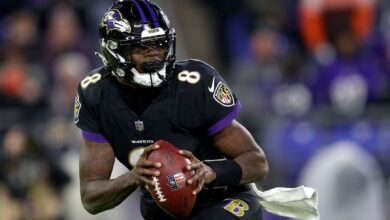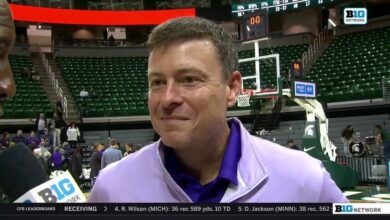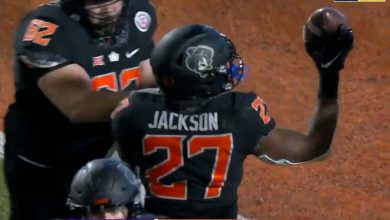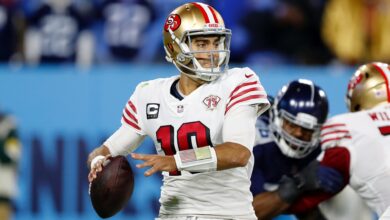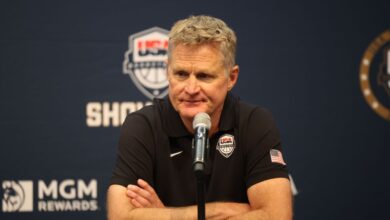Cups of coffee: Seven former NFL players remember their one and only game

The Aug. 5 enshrinement of the 2023 class will bring the membership of the Pro Football Hall of Fame to 371 inductees, an exclusive club honoring the best of the best. But there’s another group of NFL players that isn’t quite as prestigious, and its membership doesn’t come with bronze busts or gold jackets.
According to Pro Football Reference, 1,432 men have appeared in exactly one career NFL game.
For some, playing even one game is considered an unlikely success story. For others in the club, there are traces of disappointment. Whatever the circumstances, this is an undeniably exclusive group.
Approximately 1% of NFL players reach the Hall of Fame, but these “cup of coffee” guys also beat another set of incredibly long odds: Less than 1% of college football players make it to the NFL.
“I know everybody thinks, ‘Oh, poor them for having a cup of coffee,'” said Doug Whaley, who signed cup of coffee guy Glenn Gronkowski during his tenure as Buffalo Bills general manager. “But to really experience your lifelong dream and to walk out on the field at an NFL game and the fans and to experience that, people pay a lot of money for it. And I’m sure Glenn and other people that did it are at the time probably not super happy of it only being one. But now when you reflect back, that’s a major, major accomplishment.”
ESPN spoke to seven members of the Cup of Coffee Club to discuss their remarkable, if fleeting, NFL experiences:
Jump to:
Glenn Gronkowski | Matt Kinzer | Chad Kelly
Kerwin Bell | Cephus Weatherspoon
Jordan Bernstine | Ted Karras Jr.

‘The Real Baby Gronk’
Name: Glenn Gronkowski
Position: Fullback
Team: Buffalo Bills
Game played: Sept. 11, 2016: Bills at Ravens
Notable stats: 8 offensive snaps, 1 holding penalty
Glenn Gronkowski felt every ounce of pressure going into his first career NFL game.
An undrafted rookie, Gronkowski had already beaten the odds by making the Buffalo Bills’ 53-man roster out of training camp, but the fullback knew it was just the first hurdle in the NFL’s infinite obstacle course.
The youngest of the famed Gronkowski brothers, Glenn was all too familiar with the churn of the NFL. Rob, four years his senior, had two Super Bowl appearances by the time Glenn made it to the NFL, while Dan and Chris were out of the league after playing three seasons each.
Though he’s the youngest and smallest of five — the original Baby Gronk — Glenn’s dad, Gordy, called him the most athletic Gronkowski.
“Unfortunately I never got the size like Rob did,” Glenn said. “Otherwise, I think I could have been a really good tight end and definitely had the receiving skills. … Usually when we all play sports together, it’s a battle between me and Rob for who comes out as the champion in the end, whether it’s basketball or other yard games.”
After three seasons at Kansas State and a second-team All-Big 12 nod, Gronkowski’s last name helped him generate some buzz in the pre-draft process. He ultimately went undrafted, but he landed in a good spot with the Bills — his hometown team and one that still utilized a fullback.
Though Glenn made the initial roster, he learned the organization brought another fullback in for a tryout during the first week of the regular season. A surprise failed physical from a previously undiscovered broken bone kept the player from taking a roster spot that week, but Glenn felt the grains of sand picking up pace as they slipped through the hourglass of his NFL career. To have any hope at reversing the momentum mounting against him, he had to have a good game in Buffalo’s season opener against the Ravens in Baltimore.
“I was kind of a bubble player, so I knew I needed to perform,” Glenn said. “I remember taking it all in, the flyovers in the stadium, really trying to take it all in because I didn’t know how long it was going to last.”
It lasted eight snaps.
Glenn’s name appears in the official play-by-play only once: for an offensive holding penalty on the Bills’ first drive of the second quarter. As he remembers it, the play was a corner blitz off the right side. Though the fullback initially picked it up, quarterback Tyrod Taylor scrambled out of the pocket, and as the corner tried to follow Taylor, Glenn held on a little too long.
“I definitely did hold him a little bit,” he said. “I thought I got away with it, and then I was actually facing the judge that ended up throwing the flag. I was hoping it wasn’t on me because he was kind of far away, but he did catch it.”
Glenn didn’t leave the sideline in the second half, and the next day, right before a team meeting, he got a text from his agent that he was going to be released.
“I kind of expected it because I didn’t play a single snap in the second half, so I kind of figured something was up,” Glenn said. “It was kind of funny that I heard it from my agent first, and then I kind of had to sit through a whole team meeting and then find out from there.”
Glenn hasn’t watched the tape from his lone NFL game. Nearly seven years later, he’s not even sure how he’d get a copy of it.
He never played another regular-season NFL snap, but he did win a Super Bowl ring later that season with Rob as a member of the New England Patriots‘ practice squad.
“I know some players play 15 years, never get one,” Glenn said. “… I’m 1-for-1. One game, one Super Bowl ring.”
‘The Liger’
Name: Matt Kinzer
Position: Punter
Team: Detroit Lions
Game played: Oct. 11, 1987: Lions at Packers
Notable stats: 7 punts, 238 yards, 34 yards per punt, long of 42 yards
Matt Kinzer thought he was in trouble when Lions coach Darryl Rogers made a beeline toward him during a tryout in September 1987.
Moments earlier, Kinzer booted a punt well over 50 yards, the ball bouncing into Rogers’ 7-on-7 drill. Kinzer scrambled to apologize for interrupting practice, but instead of scolding him, Rogers made Kinzer an offer: If he could punt the ball over a chain hanging from the rafters of the Pontiac Silverdome, Kinzer could walk up to owner William Clay Ford Sr.’s office right then and there and sign an NFL contract.
Kinzer cleared it on his third attempt.
“[Rogers] just giggled and said, ‘You go up to Mr. Ford’s office,'” Kinzer said.
The NFL was never part of the plan for Kinzer, whose boyhood dream was to play professional baseball. Instead, he became one of 68 men to play an NFL and MLB game, per Baseball Almanac — and the only one to play a game for both the Detroit Tigers and Detroit Lions, making him an actual, real-life Liger.
“I joke about it saying, yeah, Deion [Sanders] and Bo [Jackson], they were just OK,” Kinzer said with a chuckle. “But I do take a lot of pride in it.”
Kinzer started punting as a high school freshman in Indiana almost by accident when a coach happened to see him try to outkick a friend in an informal competition. The coach told him that he had potential, and if he kept working at it, he could go to college for free. Kinzer fell in love with the process, competing against himself to get the tightest spiral, or to send it end over end as far as he could. Because Purdue was the only school that agreed he could play baseball and football, Kinzer became a Boilermaker.
In three seasons as Purdue’s starting punter from 1981 to ’83, Kinzer averaged 39.6 yards per punt, before embarking on his MLB journey as a second-round pick in 1984.
Then a minor league pitcher in the Cardinals’ system, Kinzer was in Fort Wayne, Indiana, after the 1987 season when a football teammate from Purdue called him out of the blue.
“Hey Boomer, what’s going on?” linebacker Roosevelt Barnes said, calling Kinzer by his college nickname. “I want to let you know the Lions are having a cattle call tryout for punters. You need to come up here, Boomer.”
“Rosie,” Kinzer remembered telling his friend, “I haven’t punted a football in three years.”
Barnes responded with a number for Kinzer to call and arrange the tryout. Kinzer briefly debated it with his then-wife and friends before picking up the phone.
“It was one of those, ‘I want to see if I can. If I can’t, that’s great, too,” Kinzer said. “At least, hey, I got to go punt in the Silverdome.”
A couple of weeks after landing a contract from the successful tryout, Kinzer added another landmark to his ledger of punting locations: Lambeau Field.
Signed just before the NFL players’ strike, Kinzer stayed on with the team and got his chance after Rogers grew frustrated with starting punter Jim Arnold in the Lions’ Week 3 loss to the Buccaneers. He told Kinzer, who was standing on the sideline, he would get his shot the next week in Green Bay.
“I said, ‘Oh, crap,'” Kinzer said. “… I had to learn how to hold for the kicker. I never had to do that. Quarterbacks did that at Purdue. … My first ball I held for him, I forgot to spin the ball, the laces. I got it down, and I said, ‘How was that?’ [Kicker Mike Prindle] goes, ‘That’s great. Next time spin the ball.'”
Kinzer wound up punting seven times for 238 yards — including a long of 42 yards — in his NFL debut.
“It was so cold, and I had to go to the bathroom, and you can’t go until halftime,” Kinzer said. “It was the middle of the first quarter, and I’m just like, this is something else.”
Afterward, Kinzer knew pretty quickly that game would be his last. Once the adrenaline wore off, he felt excruciating pain from a pulled hamstring and several bone spurs under his right knee cap.
“I’m like, this is so easy, like riding a bike,” Kinzer said. “And then I’m like, ‘Oh my gosh, I haven’t done this in three years. I’m out of shape. My legs are killing me.’ And I couldn’t do it anymore.”
He returned to baseball in 1988, eventually reaching the big leagues with St. Louis in 1989 and appearing in nine career MLB games as a Cardinal and Tiger. But it’s his single NFL game that has helped Kinzer carve out a unique kind of immortality.
“I enjoy telling the story,” Kinzer said, “and enjoy saying, yes, I played at Lambeau Field.”
‘The Mr. Irrelevant’
Name: Chad Kelly
Position: Quarterback
Team: Denver Broncos
Game played: Oct. 14, 2018: Broncos vs. Rams
Notable stats: minus-1 rushing yard
For a moment, Chad Kelly understood what it felt like to be an NFL quarterback.
As Broncos starting quarterback Case Keenum got evaluated for a concussion in the final seconds of the first half against the Rams in 2018, Kelly trotted out to a frenzied crowd at Mile High Stadium. He pressed his hands to the sides of his helmet, straining to hear the coach’s call over the roar. After Kelly broke the huddle, center Matt Paradis snapped the ball to the quarterback, and in one fluid motion, the once-heralded prospect took a knee to end the half. That’s it. That’s the only regular-season NFL snap taken by the wunderkind-turned-cautionary-tale.
“The crowd went crazy just for a kneel-down,” Kelly said. “I remember right after I took a knee, Aaron Donald came up and said some very positive things to me. Then I kind of turned around after, and I was like, wait, that was Aaron Donald? It kind of took me by surprise. I felt like I almost belonged, hearing something from a guy like him.”
And maybe Kelly did belong — maybe he still does. The nephew of legendary Bills quarterback Jim Kelly, Chad Kelly had the pedigree, talent, and yes, swagger, to carve out his own path in professional football. But a series of off-the-field transgressions and arrests, continuing a pattern that began forming during his high school football days, derailed his NFL career.
“It’s one that I don’t wish upon anybody, personally,” Kelly said of his journey. “… But I think all the things that I’ve been through have shaped me to become the person I am and the quarterback I am, and the mature person I am today.”
After being kicked off the Clemson football team and finding second chances at East Mississippi Community College and Ole Miss, Kelly got his long-awaited shot at professional football when the Broncos made him “Mr. Irrelevant” with the last pick in the 2017 NFL draft. Wrist surgery and a prolonged ACL rehab kept him sidelined for the 2017 season, but when he resumed competing in 2018, he won the backup quarterback job over former first-round pick Paxton Lynch. Kelly had a strong showing in the Broncos’ preseason — including the opener where he completed 14 of 21 attempts for 177 yards, two touchdowns and an interception to a chorus of “KEL-LY” chants from the crowd.
As Keenum’s backup, Kelly appeared to be on the right track in his second NFL season, but he got in his own way. Again.
Less than two weeks after he saw his first NFL regular-season action, Kelly was arrested on suspicion of first-degree criminal trespassing and was promptly released by the Broncos the next day. After pleading guilty to misdemeanor second-degree criminal trespassing, Kelly signed with the Colts prior to the 2019 season. He served a two-game suspension for violating the NFL’s personal conduct policy with the Colorado arrest and spent the next year bouncing between the Colts’ active roster and practice squad. Around that time, Kelly heard that one of his former coaches told someone the quarterback hadn’t hit rock bottom yet. That struck a chord with Kelly.
“At that moment, it kind of ticked me off in a way,” he said. “They don’t know what I’ve been through, and they don’t know what rock bottom felt like, because I did hit rock bottom. I think from that moment on I was pissed off to be really, really great.”
After a two-year playing hiatus and a brief detour into coaching, Kelly returned to professional football when he signed with the Toronto Argonauts of the CFL in 2022. He became an unlikely hero in the 109th Grey Cup when starting quarterback McLeod Bethel-Thompson injured his throwing hand in the fourth quarter. This time, Kelly came off the bench for more than a kneel-down. He helped the Argos to a 24-23 comeback victory for their 18th Grey Cup Championship and started the 2023 season as the team’s starting quarterback — but the 29-year-old still has an eye on making a return to the league across the border.
“Getting a little taste of one snap in the NFL,” Kelly said, “it’s almost like the biggest tease of all teases, right? You’re just there to kneel the ball down, not even there to actually run a play or hand it off. I definitely have just learned to take every moment for what it is and enjoy where you’re at in this present moment and understand the capabilities and things that you could endure throughout the life and just be able to approach every day like it’s your last.”
‘The Record Holder’
Name: Kerwin Bell
Position: quarterback
Team: Indianapolis Colts
Game played: Dec. 5, 1996: Colts vs. Eagles
Notable stats: 5-for-5, 75 yards, 1 TD, four first downs, 158.3 passer rating
Kerwin Bell’s résumé reads like a screenplay.
A small-town Florida kid who walked on to the Florida football team, Bell became a folk hero when he went from eighth string to starting quarterback, Heisman candidate and SEC Player of the Year. But Florida’s NCAA probation that included a three-year bowl and television ban reduced Bell’s visibility with scouts, and he fell to the seventh round, where he was drafted by a Miami Dolphins team that had Dan Marino on its roster.
After an ACL injury, he bounced around the CFL, World Football League and the bottom half of NFL rosters for nearly a decade. Then, with starting quarterback Jim Harbaugh already sidelined with a knee injury for a must-win Thursday night game against the Eagles in 1996, backup Paul Justin went down in the third quarter.
Bell was the Colts’ third-string quarterback, and just like that, he’s up.
He completed his first pass to Marshall Faulk for 11 yards. Two plays later, he hit rookie Marvin Harrison for a 20-yard touchdown, and the Colts took a 30-3 lead.
Only thing that was missing was an uplifting soundtrack for the montage of his climb back to the NFL.
“I told people I was not going to give up,” said Bell, now the head coach at Western Carolina. “It’s demoralizing when you get cut, it gets in the paper, and people know you’re sort of a failure at your craft. … I think that’s what I feel the most proud about, is that I never gave up on my dream.”
“… I thought I’d have a chance to do great things, but it didn’t work out the way I wanted to. But I never let it slow me down from really trying to do everything I could. And when I had that opportunity, I took advantage of it in that one game.”
Bell finished his lone game with a historic stat line: 5-for-5, 75 yards, one touchdown and four first downs — all adding up to an NFL-best 158.3 passer rating. Harbaugh came back the next week, and Bell never got another regular-season game again. He returned to the CFL before transitioning to coaching.
“I tell people all the time, I am the highest-rated quarterback in the history of the NFL and also I’m in the NFL Hall of Fame,” said Bell, who is included in a display at the museum in Canton, Ohio, for wearing the first in-game helmet cam. “So my career was pretty good, even though I only played one game.”
‘The Speedster’
Name: Cephus Weatherspoon
Position: Wide receiver
Team: New Orleans Saints
Game played: Nov. 5, 1972: Saints at Vikings
Notable stats: Special teams snaps
Cephus Weatherspoon went to Fort Lewis College in Durango, Colorado, to run track and play basketball, but playing in his dorm’s intramural football championship changed the trajectory of his life.
“The college coach came out and saw this tall, lanky Black kid catching touchdowns,” Weatherspoon said. “My dorm won the championship, and that’s when he talked to me and planned it out.”
A gifted wide receiver nicknamed “The Speedster,” Weatherspoon hadn’t played football in junior college and played only two seasons at Fort Lewis. Even so, he caught the eye of NFL scouts after his junior year. Eventually, five or six scouts came to Fort Lewis to time the wide receiver and watch him catch passes. A couple of months later, the Saints selected him in the 13th round of the 1972 draft.
“I beat out guys in the third round, fourth round when I went to camp with the New Orleans Saints, from the draft choices, rookies and the veterans,” Weatherspoon said. “We had about 15 receivers in camp. And that time they only kept about five.”
Weatherspoon wasn’t one of them, but he did make the taxi squad, and his speed caught the eye of quarterback Archie Manning.
Weatherspoon got called up to the 40-man squad midway through his rookie season and traveled to Minnesota. After the game, Weatherspoon went back down to the taxi squad.
“I played in every play on the kickoff returns, and I did kickoff,” Weatherspoon said. “I was going down on the kickoff, and hey, that was it. It was great.
“But it was a little disappointing for me because I felt that I could have stayed around. They liked me. Archie and [wide receiver] Danny Abramowicz really liked me.”
Weatherspoon was traded to the Denver Broncos before the 1974 season, but after appearing in the team picture, he got cut.
“It was short and sweet,” Weatherspoon said. “I got my degree, and that was my career. But I did more than most. At least I made it to the show. A lot of guys don’t make it through preseason, you know what I mean? But it’s all good. No regrets. It opened a lot of doors for me for the short time I was there.”
After stints in the World Football League and semipro football, Weatherspoon hung up his cleats and used his degree in education and bioscience to work in the medical field as a hospital sales rep and with charities in Southern California.
“Hey, for a little Black kid coming out of a little small high school in Globe, Arizona, I’m the first one ever that made it to the pros for my high school ever,” Weatherspoon said. “Nobody ever went that far from Globe, Arizona.”
‘The Mentor’
Name: Jordan Bernstine
Position: Safety
Team: Washington
Game played: Sept. 9, 2012: Washington at Saints
Notable stats: 15 special teams snaps
Jordan Bernstine stood up gingerly on the turf at the Superdome and took a step. As he started to take a second, athletic trainers sprinted toward him, shouting to stop walking and sit down. Less than 12 minutes remained in Bernstine’s debut as a seventh-round rookie in Washington’s season opener against the Saints in 2012, but he wouldn’t take another snap that day. Or ever again.
What he thought initially was a sprained right knee from two blockers rolling up on him from behind as he engaged another blocker during a kickoff turned out to be a torn ACL, MCL, PCL and patellar tendon. After a promising preseason, Bernstine’s season was over.
“I went from being one of the fastest players on the [team] to being told on Monday that I probably would not walk, jog, or do any of these things without a limp,” he said. “My response was, ‘Well, what’s the recovery time?'”
Undeterred even as doctors mentioned the possibilities of permanent nerve damage or even a below-the-knee amputation, Bernstine battled through rehab before being cut during training camp in 2013 because his knee wasn’t ready. He moved to Colorado with his uncle Rod Bernstine, an NFL alum, and kept working until he landed several NFL workouts in 2014. But a partially retorn ACL during one of those sessions sent him back for another round of surgery and rehab to kick off 2015.
Eleven years after his lone NFL game, Bernstine laughs as he talks about the catastrophic injury and the subsequent years of rehabilitation. It’s not a bitter, sarcastic laugh, but one laced in the incredulity of his hyper-focused, relentless pursuit of returning to the NFL.
“It’s hilarious when I say this out loud and think about it in retrospect,” Bernstine said. “I was just so focused — the blinders of the NFL and it getting cut short so soon. I’d always come back from these injuries and come back faster and stronger.”
But not this time.
Bernstine would find a second act and a new passion through his adversity.
For the past six years, the former safety has been running Ground Up Sports Performance in Colorado Springs, a training facility for kids in the area. During his grueling two-a-day workouts to rehab from his second ACL repair, Bernstine started attracting attention from area high schoolers who were curious about the hard-working NFL safety. They started working out with him, asking for pointers as they prepared to go off to their college programs. Soon, Bernstine realized he was spending three hours a day at the gym, often not even doing his own workout as he helped the younger guys.
“It’s just developing humans, teaching people how to commit to the process, teaching people how to handle adversity,” Bernstine said. “Teaching people that it’s not going to be as easy or go the way that you planned in your head, alright, these things might happen, and if they do, how are you going to respond from those things?”
Bernstine opened his facility in 2017 when his first gym relocated, and he’s using his journey as a football player as a blueprint for his next act as a business owner.
“I’m very grateful for where I’m at at this point in time with our business and with where we’re at, being able to keep growing and I just love it,” Bernstine said. “I really found something that rivals that feeling that I had with football.”
‘The Replacement’
Name: Ted Karras Jr.
Position: Defensive tackle
Team: Washington
Game played: Oct. 4, 1987: Washington vs. Rams
Notable stats: 1 sack
The first thing Ted Karras Jr. remembers about his first NFL game is everyone hated him.
And not just him, but the entire Washington football team — at least the version that walked into RFK Stadium on Oct. 4, 1987.
A defensive tackle on Washington’s roster of replacement players during the 24-day player strike, Karras vividly remembers the jeering fans and protesters, including guys he once called teammates.
“Everyone was against us to begin the game,” said Karras, now the head football coach at Marian University in Indianapolis. “The Cardinals came to Washington, and there was a crowd there and there were picket lines. Everything and everyone was kind of against us.”
But not for long.
Karras recorded a sack, replacement wide receiver Anthony Allen set a franchise receiving record and Washington beat the St. Louis Cardinals 28-21.
“I thought it was the greatest feeling in the world,” Karras said of his third-quarter sack. “I was fired up. The fans were fired up. The team was fired up.
“… At the end of the game, the fans were all yelling to everyone outside to stay on strike, which I found to be fascinating.”
Undrafted out of Northwestern, Karras came from a football family. His dad, Ted Sr., played nine seasons and won a championship with the Chicago Bears, and his uncle Alex was named to four Pro Bowls with the Lions. Another uncle, Lou, played for Washington until an eye injury ended his career. Karras looked to join the family business, but after being signed by Washington as an undrafted free agent, he got cut when the team reduced the roster to 60 during training camp. With the prospects of continuing a football career narrowing, Karras began studying for the Series 7 exam to become a licensed stockbroker. Then he got another call from Washington, and he put the books down.
“I talked to my dad about it, and he was like, ‘Yeah, you’ve got to go,'” said Karras whose son Ted III is currently the Bengals center. “Football’s not a right; it’s a privilege. We were all getting another opportunity — and with the team that I was with for the prior six months.”
It was an opportunity, sure, but it came with its own set of risks. A throng of angry protesters and players greeted Karras and his teammates — derogatorily nicknamed the “Scabskins” for crossing the picket line — when they arrived by bus to the facility for their first practice. Defensive tackle Darryl Grant, one of the Washington players on strike, punched and broke a window of the bus.
“I’m all for adventure,” Karras said. “It didn’t curtail really any of us. We were a pretty resolute group. We were just like, ‘Hey, we’re getting our shot, these games count, we want to do a good job,’ and ended up doing that.”
Officially, Karras played in one of Washington’s three games with replacement players, but he remembers suiting up for two and getting in for a play during Washington’s improbable win against the Dallas Cowboys.
When the strike ended and the original players rejoined the team, Karras’ football career was over, and he watched from home as Washington finished the season under Super Bowl confetti.
But more than three decades after stepping on the field at RFK Stadium, Karras got a Super Bowl ring when the organization decided to recognize the replacement players following the release of ESPN’s 30 for 30 documentary on the season.
“Three games constitutes a year in the NFL,” Karras said. “We got some of the money, but we never got the rings. And then this 30 for 30 [2017’s “Year of the Scab”] came out, and yes, it was beautiful. We went out there, saw all the guys, got our rings 30-some years later. It was unbelievable.
“I had a cup of coffee, but it was the best damn cup of coffee I ever had.”
